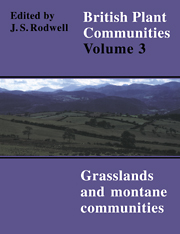Book contents
- Frontmatter
- Contents
- List of Figures
- Preface and Acknowledgements
- Preamble
- Mesotrophic Grasslands
- Community Descriptions
- Calcicolous Grasslands
- Community Descriptions
- Calcifugous Grasslands and Montane Communities
- Community Descriptions
- Index of Synonyms to Grasslands and Montane Communities
- Index of Species in Grasslands and Montane Communities
- Bibliography
CG3 - Bromus Erectus Grassland
Published online by Cambridge University Press: 04 July 2020
- Frontmatter
- Contents
- List of Figures
- Preface and Acknowledgements
- Preamble
- Mesotrophic Grasslands
- Community Descriptions
- Calcicolous Grasslands
- Community Descriptions
- Calcifugous Grasslands and Montane Communities
- Community Descriptions
- Index of Synonyms to Grasslands and Montane Communities
- Index of Species in Grasslands and Montane Communities
- Bibliography
Summary
Synonymy
Chalk grassland auct. angl. p.p.; Brometum auct. angl.; Zernetum auct. angl.; Cirsio-Brometum Shimwell 1968a p.p.; Cirsio-Brometum Shimwell 1968a emend. Willems 1978 p.p.
Constant species
Bromus erectus, Carexflacca, Festuca ovina, Lotus corniculatus, Plantago lanceolata, Sanguisorba minor.
Rare species
Aceras anthropophorum, Astragalus danicus, Carex humilis, Hypochoeris maculata, Linum perenne ssp. anglicum, Phyteuma tenerum, Polygala calcarea, Pulsatilla vulgaris, Senecio integrifolius ssp. integrifolius, Thesium humifusum, Thymus pulegioides.
Physiognomy
This community comprises all those swards in which B. erectus makes up more than 10% of the cover and where other grasses of similar physiognomy, notably Brachypodium pinnatum and Avenulapubescens, make a usually negligible contribution. It includes vegetation which is similar in floristics and structure to the Festuca-Avenula grassland as well as some where the dense tussocks of B. erectus have a much more dominating effect. Taking the community as a whole, however, the most obvious general feature is the markedly reduced frequency here of most chamaephytes (Thymus praecox, Hieracium pilosella, Helianthemum nummularium), those hemicryptophytes which cannot produce extensive bushy sprawls of shoots, large rosettes or tall leafy stems (Asperula cynanchica, Koeleria macrantha, Briza media, Scabiosa columbaria, Campanula rotundifolia, Plantago media), certain therophytes (Linum catharticum, Gentianella amarella) and bryophytes (Pseudoscleropodium purum, Homalothecium lutescens and acrocarps of patches of bare soil). The most frequent associates overall are all hemicryptophytes which can persist by depressing or growing through the coarse, bulky foliage of the dominant and its accumulating litter: Sanguisorba minor, Carex flacca, Plantago lanceolata, Cirsium acaule and Lotus corniculatus. Festuca ovina seems to survive the presence of substantial amounts of B. erectus, though it often persists patchily and, in the rankest swards, it is commonly replaced by F. rubra in a tussocky form.
The rare species which are such a distinctive feature of certain kinds of Festuca-Avenula grassland are also, for the most part, reduced here. Some of those which are more frequent and widespread in that community are chamaephytes (Polygala calcarea, Thesium humifusum) or diminutive geophytes (Orchis ustulata, Herminium monorchis, Spiranthes spiralis) which are readily overwhelmed. Others fare better. Phyteuma tenerum, for example, can persist in numbers and with a splendid stature in these coarser swards (e.g. Wells 1975). Senecio integrifolius ssp.
- Type
- Chapter
- Information
- British Plant Communities , pp. 166 - 177Publisher: Cambridge University PressPrint publication year: 1992



